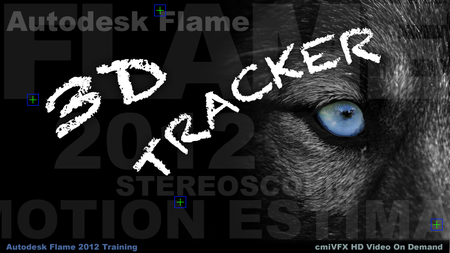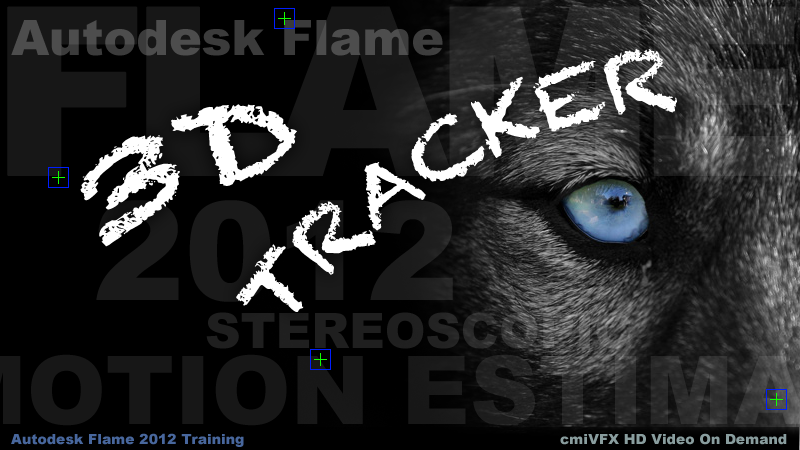cmiVFX - Autodesk Flame 3D Tracking
English | Video: h264, yuv420p, 1024x820, 499 kb/s | Audio: aac, 22050 Hz | 2.52 Gb
Genre: eLearning
cmiVFX launches its latest full feature training video for Autodesk's Flame Premium 2012 Compositing Package. For years, the high end systems from Autodesk have had Camera Trackers to help digital match moving between Computer Graphics and Live Action Footage. This year, cmiVFX pulls out the big guns, and triggers a feature length 3D Tracking training video that will get any Flame artist to be an expert in the art of digital match moving. New for 2012, the Autodesk Flame tracking system within its Action module, has been reorganized and updated to work with the new user interface layout. New tools like the Analyzer and Stereo Analyzer, now give artists multiple opportunities to extract 3d point cloud data in a single Action session
By utilizing these new features along with batch, one can now be worry free of running into errors in a 3d track. Resetting just one of those node streams will now preserve all of your previous processing hard work in that Action session. We will show you how to optimize your matchmaking in several ways. Like in many of our cmiVFX videos, we show you several roads to travel on, so that you can arrive at the same destination. Learn which methods are faster, and under which circumstances that they work properly. This video will show you how to do basic tracking through Stereoscopic tracking, and everything in between. And if that wasn't enough, we delve into some more advanced topics on handling shots that have been poorly supervised and lacking the proper details to obtain a solid track. Here at cmiVFX, we never give up on a shot… no matter how many times it wants to make you fail! This video is a MUST HAVE for anyone with access to a Flame currently, and anyone who wants to learn how to use one.
Introduction
In this chapter we get introduced to some of the latest news topics surrounding the subject of Autodesk Flame Tracker and some of its underlying modules. Find out some quick info before you start getting into deeper waters.
Tracking Basics
Just in case your are unfamiliar with any kind of tracking, we will get you familiar with the very basics by showing you 1 and 2 point tracking along with image stabilization. Without this basic knowledge, you wont understand completely how the 3D Tracker addresses its point values. This chapter has multiple smaller projects that are purely for tool description and functionality. There are many places to find a tracker in Flame Premium, however we show you where most of them are.
Lens Distortion
If you can determine lens distortion from any of your footage that you will be tracking, it is best to remove it as best as possible. There are new places to remove lens distortion inside the latest versions of Flame, so its important to show you which ones work the best, alternative methods, and optimized workflows. The new Action node bin gives you the control of a batch tree, and you want to make sure you do not duplicate any tasks up or down stream. This chapter covers the tools in both Batch and Action.
Pre-Processing Concepts
In some instances, your clips could have a blue or green screen, terrible noise, rolling shutter issues, and a myriad of other issues that you may not even be aware of. This particular chapter discusses how to optimize your clips based on their problematic issues. We found the most difficult clips for you to track, so that by example, you will be able to solve any shot on your own in the real world.
Ground Plane Definition
When creating a camera track, you will need to decide if you are going to be mixing live action with 3rd party geometry in the Action Module. This will require you to set a ground plane for your objects to sit on. (If the shot requires them) Many times, foreground points are minimal in a 3D Tracking process due to the speed of the elements and potential motion blur issues. Use one of our difficult shots to try to get a ground plane from a low contrast pavement, so you can add CG to it. (We also include shots with detailed ground to make it easier for practicing on your own)
Stereoscopic Tracking
This is a very exciting topic, and we will tackle it after you get the basics and intermediate concepts under control. Relationships with left and right stereo clips are the main focus. We show you how to enter a stereoscopic assignment Action in Batch tree, how to manage and create stereo clips from previously single left / right clips, and we show you how to track and sync the shots in Action for later processing. We include stereoscopic HD footage, as well as the knowledge to create your own stereo clips using the basic and default Action tools.
Tips, Tricks Part 1
In this chapter we show you how to isolate and track individual channels after some simple Batch Processing. This will yield and even better result that the very same clip we processed in RGB earlier in this video. We also take this mini project setup to a simple Sky Replacement setup in conjunction with a Key. You wont want to miss this chapter. For more reference on channels and how modifying them can give you ultimate control, please check our our Flame Keying Video.
Object Tracking
Inside of Flame you have the option to extract secondary motion from a shot after the initial camera track. This gives you the opportunity to pull out a point cloud that you can then export to motion capture, or a animation department for more detailed CG animation. You can also use it to help you with different Motion Graphic Design elements in a more Broadcast environment.
Tips, Tricks Part 2
Sometimes you will get very long clips that NO tracker can seem to track. You might need to split the shot into several shots and track them separately. The problem now becomes, how does one get all that into one shot. We will discuss a few concepts in achieving this goal.



